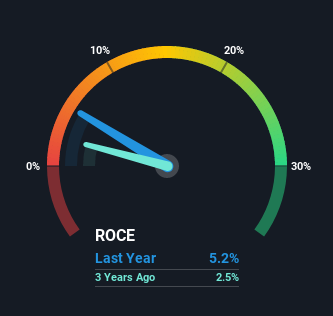- United States
- /
- Software
- /
- OTCPK:AVYA.Q
Some Investors May Be Worried About Avaya Holdings' (NYSE:AVYA) Returns On Capital
If we want to find a potential multi-bagger, often there are underlying trends that can provide clues. Typically, we'll want to notice a trend of growing return on capital employed (ROCE) and alongside that, an expanding base of capital employed. Put simply, these types of businesses are compounding machines, meaning they are continually reinvesting their earnings at ever-higher rates of return. Having said that, from a first glance at Avaya Holdings (NYSE:AVYA) we aren't jumping out of our chairs at how returns are trending, but let's have a deeper look.
Understanding Return On Capital Employed (ROCE)
Just to clarify if you're unsure, ROCE is a metric for evaluating how much pre-tax income (in percentage terms) a company earns on the capital invested in its business. The formula for this calculation on Avaya Holdings is:
Return on Capital Employed = Earnings Before Interest and Tax (EBIT) ÷ (Total Assets - Current Liabilities)
0.052 = US$258m ÷ (US$6.0b - US$1.1b) (Based on the trailing twelve months to June 2021).
Thus, Avaya Holdings has an ROCE of 5.2%. Ultimately, that's a low return and it under-performs the Software industry average of 10%.
See our latest analysis for Avaya Holdings

In the above chart we have measured Avaya Holdings' prior ROCE against its prior performance, but the future is arguably more important. If you're interested, you can view the analysts predictions in our free report on analyst forecasts for the company.
So How Is Avaya Holdings' ROCE Trending?
In terms of Avaya Holdings' historical ROCE movements, the trend isn't fantastic. Over the last four years, returns on capital have decreased to 5.2% from 8.9% four years ago. On the other hand, the company has been employing more capital without a corresponding improvement in sales in the last year, which could suggest these investments are longer term plays. It may take some time before the company starts to see any change in earnings from these investments.
On a related note, Avaya Holdings has decreased its current liabilities to 18% of total assets. That could partly explain why the ROCE has dropped. Effectively this means their suppliers or short-term creditors are funding less of the business, which reduces some elements of risk. Some would claim this reduces the business' efficiency at generating ROCE since it is now funding more of the operations with its own money.
The Key Takeaway
To conclude, we've found that Avaya Holdings is reinvesting in the business, but returns have been falling. And investors appear hesitant that the trends will pick up because the stock has fallen 10% in the last three years. In any case, the stock doesn't have these traits of a multi-bagger discussed above, so if that's what you're looking for, we think you'd have more luck elsewhere.
Avaya Holdings does come with some risks though, we found 3 warning signs in our investment analysis, and 1 of those shouldn't be ignored...
While Avaya Holdings isn't earning the highest return, check out this free list of companies that are earning high returns on equity with solid balance sheets.
When trading Avaya Holdings or any other investment, use the platform considered by many to be the Professional's Gateway to the Worlds Market, Interactive Brokers. You get the lowest-cost* trading on stocks, options, futures, forex, bonds and funds worldwide from a single integrated account. Promoted
New: Manage All Your Stock Portfolios in One Place
We've created the ultimate portfolio companion for stock investors, and it's free.
• Connect an unlimited number of Portfolios and see your total in one currency
• Be alerted to new Warning Signs or Risks via email or mobile
• Track the Fair Value of your stocks
This article by Simply Wall St is general in nature. We provide commentary based on historical data and analyst forecasts only using an unbiased methodology and our articles are not intended to be financial advice. It does not constitute a recommendation to buy or sell any stock, and does not take account of your objectives, or your financial situation. We aim to bring you long-term focused analysis driven by fundamental data. Note that our analysis may not factor in the latest price-sensitive company announcements or qualitative material. Simply Wall St has no position in any stocks mentioned.
*Interactive Brokers Rated Lowest Cost Broker by StockBrokers.com Annual Online Review 2020
Have feedback on this article? Concerned about the content? Get in touch with us directly. Alternatively, email editorial-team (at) simplywallst.com.
About OTCPK:AVYA.Q
Avaya Holdings
Avaya Holdings Corp., through its subsidiaries, provides digital communications products, solutions, and services for businesses worldwide.
Slightly overvalued with weak fundamentals.
Similar Companies
Market Insights
Community Narratives



